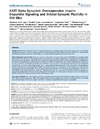Identificador persistente para citar o vincular este elemento:
https://accedacris.ulpgc.es/jspui/handle/10553/43006
| Título: | A53T-alpha-synuclein overexpression impairs dopamine signaling and striatal synaptic plasticity in old mice | Autores/as: | Kurz, Alexander Double, Kay L. Lastres-Becker, Isabel Tozzi, Alessandro Tantucci, Michela Bockhart, Vanessa Bonin, Michael Garcia-Arencibia, Moises Nuber, Silke Schlaudraff, Falk Liss, Birgit Fernández-Ruiz, Javier Gerlach, Manfred Wullner, Ullrich Lüddens, Hartmut Calabresi, Paolo Auburger, Georg Gispert, Suzana |
Clasificación UNESCO: | 320507 Neurología | Fecha de publicación: | 2010 | Publicación seriada: | PLoS ONE | Resumen: | Background Parkinson's disease (PD), the second most frequent neurodegenerative disorder at old age, can be caused by elevated expression or the A53T missense mutation of the presynaptic protein alpha-synuclein (SNCA). PD is characterized pathologically by the preferential vulnerability of the dopaminergic nigrostriatal projection neurons. Methodology/Principal Findings Here, we used two mouse lines overexpressing human A53T-SNCA and studied striatal dysfunction in the absence of neurodegeneration to understand early disease mechanisms. To characterize the progression, we employed young adult as well as old mice. Analysis of striatal neurotransmitter content demonstrated that dopamine (DA) levels correlated directly with the level of expression of SNCA, an observation also made in SNCA-deficient (knockout, KO) mice. However, the elevated DA levels in the striatum of old A53T-SNCA overexpressing mice may not be transmitted appropriately, in view of three observations. First, a transcriptional downregulation of the extraneural DA degradation enzyme catechol-ortho-methytransferase (COMT) was found. Second, an upregulation of DA receptors was detected by immunoblots and autoradiography. Third, extensive transcriptome studies via microarrays and quantitative real-time RT-PCR (qPCR) of altered transcript levels of the DA-inducible genes Atf2, Cb1, Freq, Homer1 and Pde7b indicated a progressive and genotype-dependent reduction in the postsynaptic DA response. As a functional consequence, long term depression (LTD) was absent in corticostriatal slices from old transgenic mice. Conclusions/Significance Taken together, the dysfunctional neurotransmission and impaired synaptic plasticity seen in the A53T-SNCA overexpressing mice reflect early changes within the basal ganglia prior to frank neurodegeneration. As a model of preclinical stages of PD, such insights may help to develop neuroprotective therapeutic approaches. | URI: | https://accedacris.ulpgc.es/handle/10553/43006 | ISSN: | 1932-6203 | DOI: | 10.1371/journal.pone.0011464 | Fuente: | Plos One [ISSN 1932-6203], v. 5 (7) |
| Colección: | Artículos |
Citas SCOPUSTM
110
actualizado el 08-jun-2025
Citas de WEB OF SCIENCETM
Citations
102
actualizado el 12-ene-2026
Visitas
55
actualizado el 10-ene-2026
Descargas
80
actualizado el 10-ene-2026
Google ScholarTM
Verifica
Altmetric
Comparte
Exporta metadatos
Los elementos en ULPGC accedaCRIS están protegidos por derechos de autor con todos los derechos reservados, a menos que se indique lo contrario.
